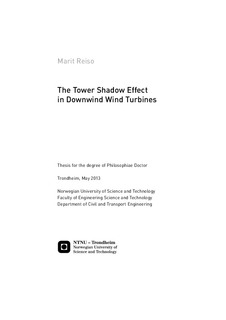| dc.contributor.author | Reiso, Marit | nb_NO |
| dc.date.accessioned | 2014-12-19T11:30:56Z | |
| dc.date.available | 2014-12-19T11:30:56Z | |
| dc.date.created | 2013-07-11 | nb_NO |
| dc.date.issued | 2013 | nb_NO |
| dc.identifier | 636663 | nb_NO |
| dc.identifier.isbn | 978-82-471-4489-3 (printed ver.) | nb_NO |
| dc.identifier.isbn | 978-82-471-4490-9 (electronic ver.) | nb_NO |
| dc.identifier.uri | http://hdl.handle.net/11250/232389 | |
| dc.description.abstract | Scarcity of land sites applicable for wind turbines is pushing the technology offshore. By going offshore the expenses of nearly all components increases, which has triggered extensive research with the aim of decreasing component costs, and increasing reliability, as also maintenance costs increase as going offshore.
The focus of this thesis is to look at ways to reduce aerodynamic loads which can contribute in lowering structural fatigue loads and thereby component costs for offshore wind turbines. The loading is mainly reported as blade root flapwise bending moment on wind turbines intentionally made for bottom fixed offshore sites. The load reduction is investigated using a different wind turbine configuration with a downwind mounted rotor and further compared with the conventional upwind mounted rotor on a monopile tower. Blades on downwind mounted rotors are exposed to the fluctuating wake behind the towers, known as the tower shadow. The influence from the tower shadow on blade fatigue loads is investigated using three different types of towers; a full height truss type tower, a faring (airfoil shaped) tower and a monopile tower.
For reliable wind turbine simulations with downwind mounted rotors, an accurate tower shadow model is essential. Thorough investigations of the tower shadow is presented, including the detailed flow picture of the mean velocity deficit, unsteady and turbulent motions, as well as velocity spectra. The tower shadow is investigated in three different ways; using three dimensional physical model scale experiments, steady tower shadow models and two dimensional computational fluid dynamic (CFD) simulations.
By use of the tower shadow from the CFD simulations, an artificial increase in blade fatigue loading is seen as the transversal grid is made coarser. Although this is a ’safe-fail’ design (for the coarser grid), it should be kept in mind as this ’simulated’ safety factor from the coarse grid simulations could increase wind turbine costs.
A method for improving the accuracy of the steady tower shadow models (currently the most frequently used model in commercial software) through a preprocessing step, where the results are directly applicable in commercial software for full wind turbine simulations, is presented. This method will improve the reliability of the simulated results. The parameters of the steady tower shadow model and the turbulence intensity are fitted and calibrated with short CFD simulations of the relevant tower geometries. This method accounts for any deviation between the mean velocity deficit obtained from the steady tower shadow model and the CFD simulations, as well as the unsteady motions and turbulence due to the presence of the tower through the calibration of the turbulence intensity (maximum deviation of ±3 percent with respect to the tower shadow based on the CFD simulations, measured as blade fatigue loading).
The response measured as blade fatigue load show an increased loading for the blades on the downwind mounted rotors using the original blades, compared to the conventional upwind mounted rotor on a monopile tower. Introducing softer and lighter blades changed this result, with reductions in blade fatigue loading (compared to the upwind mounted rotor with the original blades) of three, four and five percent for the monopile, truss and fairing towers, respectively. | nb_NO |
| dc.language | eng | nb_NO |
| dc.publisher | Norges teknisk-naturvitenskapelige universitet, Fakultet for ingeniørvitenskap og teknologi, Institutt for bygg, anlegg og transport | nb_NO |
| dc.relation.ispartofseries | Doktoravhandlinger ved NTNU, 1503-8181; 2013:188 | nb_NO |
| dc.relation.haspart | Reiso, Marit; Moe, Geir. BLADE RESPONSE ON OFFSHORE BOTTOM FIXED WIND TURBINES WITH DOWN-WIND ROTORS. In Proceedings of the 29th International Conference on Ocean, Offshore and Arctic Engineering: 499-504, 2010. <a href='http://dx.doi.org/10.1115/OMAE2010-20586'>10.1115/OMAE2010-20586</a>. | nb_NO |
| dc.relation.haspart | Reiso, Marit; Muskulus, Michael; Moe, Geir. Tower Shadow - Experiment Comparing Wake Behind Tubular and Truss Towers. Proceedings of the Twenty-First (2011) International Offshore and Polar Engineering Conference: 335-341, 2011. | nb_NO |
| dc.relation.haspart | Hagen, Torbjorn Ruud; Reiso, Marit; Muskulus, Michael. NUMERICAL TOWER SHADOW MODELING FOR A DOWNWIND WIND TURBINE TRUSS TOWER. PROCEEDINGS OF THE ASME 30TH INTERNATIONAL CONFERENCE ON OCEAN, OFFSHORE AND ARCTIC ENGINEERING, VOL 5: OCEAN SPACE UTILIZATION ; OCEAN RENEWABLE ENERGY: 859-870, 2011. <a href='http://dx.doi.org/10.1115/OMAE2011-50118'>10.1115/OMAE2011-50118</a>. | nb_NO |
| dc.relation.haspart | Hagen, Torbjørn Ruud; Reiso, Marit; Muskulus, Michael. Numerical Analysis of Turbulent Flow Past a Truss Tower for Offshore Downwind Turbines. Proceedings of the Twenty-First (2011) International Offshore and Polar Engineering Conference: 319-326, 2011. | nb_NO |
| dc.relation.haspart | Reiso, M.; Muskulus, M.. Resolution of tower shadow models for downwind mounted rotors and its effect on the blade fatigue. . | nb_NO |
| dc.relation.haspart | Reiso, Marit; Muskulus, Michael. The simultaneous effect of a fairing tower and increased blade flexibility on a downwind mounted rotor. Journal of Renewable and Sustainable Energy. (ISSN 1941-7012). 5, 2013. <a href='http://dx.doi.org/10.1063/1.4803749'>10.1063/1.4803749</a>. | nb_NO |
| dc.relation.haspart | Reiso, M.; Hagen, T.R.; Muskulus, M.. A calibration method for downwind wake models accounting for the unsteady behaviour of the wind turbine tower shadow behind monopile and truss towers.. . | nb_NO |
| dc.title | The Tower Shadow Effect in Downwind Wind Turbines | nb_NO |
| dc.type | Doctoral thesis | nb_NO |
| dc.contributor.department | Norges teknisk-naturvitenskapelige universitet, Fakultet for ingeniørvitenskap og teknologi, Institutt for bygg, anlegg og transport | nb_NO |
| dc.description.degree | PhD i bygg, anlegg og transport | nb_NO |
| dc.description.degree | PhD in Civil and Transport Engineering | en_GB |

